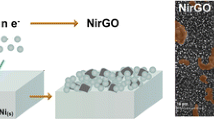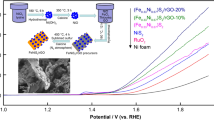Abstract
Electrocatalytic hydrogen evolution is the most cost-effective method for producing hydrogen as a large-scale clean energy source. Thus, catalysts of low-cost hydrogen evolution are developing at great speed. FeS2–reduced graphene oxide (RGO) hybrid catalysts are synthesized with the use of abundant and inexpensive component worldwide. The catalyst has satisfactory electrocatalytic performance and excellent stability in 0.5 M H2SO4 solution. The catalyst supported by RGO is the ideal electrocatalyst with satisfactory electrical conductivity with 61 mV dec−1 of the Tafel slope. What is more, the current density changes slightly in 36 h and the catalytic performance is relatively stable at 200 mV overpotential. Therefore, the catalyst supported by RGO has high potential for industrial production due to its simple composition and satisfactory electrocatalytic effect.








Similar content being viewed by others
References
Turner J (2004) Sustainable hydrogen production. Science 305:972–974
Yang W, Shi W, Chen C, Zhang T, Liu J, Wang Z, Zhou J (2017) Efficiency analysis of a novel electricity and heat co-generation system in the basis of aluminum–water reaction. Int J Hydrogen Energy 42:3598–3604
Zeng M, Li Y (2015) Recent advances in heterogeneous electrocatalysts for the hydrogen evolution reaction. J Mater Chem A 3:14942–14962
Huang SY, Sodano D, Leonard T (2017) Cobalt-doped iron sulfide as an electrocatalyst for hydrogen evolution. J Electrochem Soc 164:F276–F282
Sheng W, Gasteiger HA, Shao-Horn Y (2010) Hydrogen oxidation and evolution reaction kinetics on platinum: acid vs alkaline electrolytes. J Electrochem Soc 157(11):B1529–B1536
Esposito DV, Hunt ST, Stottlemyer AL, Dobson KD, McCandless BE, Birkmire RW, Chen JG (2010) Low-cost hydrogen-evolution catalysts based on monolayer platinum on tungsten monocarbide substrates. Angew Chem Int Ed Engl 49:9859–9862
Xia Z (2016) Hydrogen evolution: guiding principles. Nat Energy 1(10):16155
Wang DY, Gong M, Chou HL, Pan CJ, Chen HA, Wu Y, Lin MC, Guan M, Yang J, Chen CW, Wang YL, Hwang BJ, Chen CC, Dai H (2015) Highly active and stable hybrid catalyst of cobalt-doped FeS2 nanosheets-carbon nanotubes for hydrogen evolution reaction. J Am Chem Soc 137:1587–1592
Faber MS, Lukowski MA, Ding Q, Kaiser NS, Jin S (2014) Earth-abundant metal pyrites (FeS2, CoS2, NiS2, and their alloys) for highly efficient hydrogen evolution and polysulfide reduction electrocatalysis. J Phys Chem C Nanomater Interfaces 118:21347–21356
Li H, Du M, Mleczko MJ, Koh AL, Nishi Y, Pop E, Bard AJ, Zheng X (2016) Kinetic study of hydrogen evolution reaction over strained MoS2 with sulfur vacancies using scanning electrochemical microscopy. J Am Chem Soc 138:5123–5129
Zhao X, Ma X, Sun J, Li D, Yang X (2016) Enhanced catalytic activities of surfactant-assisted exfoliated WS(2) nanodots for hydrogen evolution. ACS Nano 10:2159–2166
Popczun EJ, McKone JR, Read CG, Biacchi AJ, Wiltrout AM, Lewis NS, Schaak RE (2013) Nanostructured nickel phosphide as an electrocatalyst for the hydrogen evolution reaction. J Am Chem Soc 135:9267–9270
Kuo TR, Chen WT, Liao HJ, Yang YH, Yen HC, Liao TW, Wen CY, Lee YC, Chen CC, Wang DY (2017) Improving hydrogen evolution activity of earth-abundant cobalt-doped iron pyrite catalysts by surface modification with phosphide. Small 13:1603356
Kou Z, Xi K, Pu Z, Mu S (2017) Constructing carbon-cohered high-index (222) faceted tantalum carbide nanocrystals as a robust hydrogen evolution catalyst. Nano Energy 36:374–380
Li JS, Wang Y, Liu CH, Li SL, Wang YG, Dong LZ, Dai ZH, Li YF, Lan YQ (2016) Coupled molybdenum carbide and reduced graphene oxide electrocatalysts for efficient hydrogen evolution. Nat Commun 7:11204
Cao B, Veith GM, Neuefeind JC, Adzic RR, Khalifah PG (2013) Mixed close-packed cobalt molybdenum nitrides as non-noble metal electrocatalysts for the hydrogen evolution reaction. J Am Chem Soc 135:19186–19192
Chen WF, Sasaki K, Ma C, Frenkel AI, Marinkovic N, Muckerman JT, Zhu Y, Adzic RR (2012) Hydrogen-evolution catalysts based on non-noble metal nickel-molybdenum nitride nanosheets. Angew Chem Int Ed Engl 51:6131–6135
Fan Z, Luo Z, Huang X, Li B, Chen Y, Wang J, Hu Y, Zhang H (2016) Synthesis of 4H/fcc noble multimetallic nanoribbons for electrocatalytic hydrogen evolution reaction. J Am Chem Soc 138:1414–1419
Kamat PV (2013) Quantum dot solar cells. The next big thing in photovoltaics. J Phys Chem Lett 4:908–918
Duan X, Gao Z, Chang J, Wu D, Ma P, He J, Xu F, Gao S, Jiang K (2013) CoS2–graphene composite as efficient catalytic counter electrode for dye-sensitized solar cell. Electrochim Acta 114:173–179
Liang D, Caban-Acevedo M, Kaiser NS, Jin S (2014) Gated Hall effect of nanoplate devices reveals surface-state-induced surface inversion in iron pyrite semiconductor. Nano Lett 14:6754–6760
Wang DY, Jiang YT, Lin CC, Li SS, Wang YT, Chen CC, Chen CW (2012) Solution-processable pyrite FeS(2) nanocrystals for the fabrication of heterojunction photodiodes with visible to NIR photodetection. Adv Mater 24:3415–3420
Jasion D, Barforoush JM, Qiao Q, Zhu Y, Ren S, Leonard KC (2015) Low-dimensional hyperthin FeS2 nanostructures for efficient and stable hydrogen evolution electrocatalysis. ACS Catal 5:6653–6657
Fu Q, Bao X (2017) Surface chemistry and catalysis confined under two-dimensional materials. Chem Soc Rev 46:1842–1874
Khan AH, Ghosh S, Pradhan B, Dalui A, Shrestha LK, Acharya S, Ariga K (2017) Two-dimensional (2D) nanomaterials towards electrochemical nanoarchitectonics in energy-related applications. Bull Chem Soc Jpn 90:627–648
Zuo Y, Luo J, Cheng M, Zhang K, Dong R (2018) Synthesis, characterization and enhanced electromagnetic properties of BaTiO3/NiFe2O4-decorated reduced graphene oxide nanosheets. J Alloy Compd 744:310–320
Luo J, Xu Y, Yao W, Jiang C, Xu J (2015) Synthesis and microwave absorption properties of reduced graphene oxide-magnetic porous nanospheres-polyaniline composites. Compos Sci Technol 117:315–321
Norskov JK, Bligaard T, Rossmeisl J, Christensen CH (2009) Towards the computational design of solid catalysts. Nat Chem 1:37–46
Xu G-R, Hui J-J, Huang T, Chen Y, Lee J-M (2015) Platinum nanocuboids supported on reduced graphene oxide as efficient electrocatalyst for the hydrogen evolution reaction. J Power Sources 285:393–399
Wang S, Liao L, Shi Z, Xiao J, Gao Q, Zhang Y, Liu B, Tang Y (2016) Mo2C/reduced-graphene-oxide nanocomposite: an efficient electrocatalyst for the hydrogen evolution reaction. ChemElectroChem 3:2110–2115
Akhavan O (2015) Bacteriorhodopsin as a superior substitute for hydrazine in chemical reduction of single-layer graphene oxide sheets. Carbon 81:158–166
Kong D, Cha JJ, Wang H, Lee HR, Cui Y (2013) First-row transition metal dichalcogenide catalysts for hydrogen evolution reaction. Energy Environ Sci 6:3553–3558
Chen Y, Xu S, Li Y, Jacob RJ, Kuang Y, Liu B, Wang Y, Pastel G, Salamanca-Riba LG, Zachariah MR, Hu L (2017) FeS2 nanoparticles embedded in reduced graphene oxide toward robust, high-performance electrocatalysts. Adv Energy Mater 7:1700482
Hirata M, Gotou T, Horiuchi S, Fujiwara M, Ohba M (2004) Thin-film particles of graphite oxide 1. Carbon 42:2929–2937
Xu Z, Gao C (2010) In situ polymerization approach to graphene-reinforced nylon-6 composites. Macromolecules 43:6716–6723
Li J, Xiao G, Chen C, Li R, Yan D (2013) Superior dispersions of reduced graphene oxide synthesized by using gallic acid as a reductant and stabilizer. J Mater Chem A 1:1481–1487
Li Y, Wang H, Xie L, Liang Y, Hong G, Dai H (2011) MoS2 nanoparticles grown on graphene: an advanced catalyst for the hydrogen evolution reaction. J Am Chem Soc 133:7296–7299
Wang F, Yang X, Dong B, Yu X, Xue H, Feng L (2018) A FeP powder electrocatalyst for the hydrogen evolution reaction. Electrochem Commun 92:33–38
Li F, Zhao X, Mahmood J, Okyay MS, Jung SM, Ahmad I, Kim SJ, Han GF, Park N, Baek JB (2017) Macroporous inverse opal-like MoxC with incorporated mo vacancies for significantly enhanced hydrogen evolution. ACS Nano 11:7527–7533
Duan J, Chen S, Jaroniec M, Qiao SZ (2015) Porous C3N4 nanolayers@N-graphene films as catalyst electrodes for highly efficient hydrogen evolution. ACS Nano 9:931–940
Huang J-F, Wu Y-C (2018) Making Ag present pt-like activity for hydrogen evolution reaction. ACS Sustain Chem Eng 6:8285–8290
Yu F, Zhou H, Huang Y, Sun J, Qin F, Bao J, Goddard WA 3rd, Chen S, Ren Z (2018) High-performance bifunctional porous non-noble metal phosphide catalyst for overall water splitting. Nat Commun 9:2551
Samad L, Bladow SM, Ding Q, Zhuo J, Jacobberger RM, Arnold MS, Jin S (2016) Layer-controlled chemical vapor deposition growth of MoS2 vertical heterostructures via van der Waals epitaxy. ACS Nano 10:7039–7046
Greeley J, Jaramillo TF, Bonde J, Chorkendorff IB, Norskov JK (2006) Computational high-throughput screening of electrocatalytic materials for hydrogen evolution. Nat Mater 5:909–913
Akhavan O, Choobtashani M, Ghaderi E (2012) Protein degradation and rna efflux of viruses photocatalyzed by graphene–tungsten oxide composite under visible light irradiation. J Phys Chem C 116:9653–9659
Zou X, Zhang Y (2015) Noble metal-free hydrogen evolution catalysts for water splitting. Chem Soc Rev 44:5148–5180
Xu Y, Wu R, Zhang J, Shi Y, Zhang B (2013) Anion-exchange synthesis of nanoporous FeP nanosheets as electrocatalysts for hydrogen evolution reaction. Chem Commun (Camb) 49:6656–6658
Di Giovanni C, Wang W-A, Nowak S, Grenèche J-M, Lecoq H, Mouton L, Giraud M, Tard C (2014) Bioinspired iron sulfide nanoparticles for cheap and long-lived electrocatalytic molecular hydrogen evolution in neutral water. ACS Catal 4:681–687
Acknowledgements
This work was supported from the National Natural Science Foundation of China (21606151, 21504057 and 21707092), Shanghai Excellent Technology Leaders Program (17XD1424900), Shanghai Leading Talent Program (017), Science and Technology Commission of Shanghai Municipality Project (18090503800), Shanghai Natural Science Foundation of Shanghai (17ZR1441700 and 14ZR1440500), Collaborative Innovation Fund of SIT (Project Number XTCX2015-9).
Author information
Authors and Affiliations
Corresponding authors
Rights and permissions
About this article
Cite this article
Jiang, J., Zhu, L., Chen, H. et al. Highly active and stable electrocatalysts of FeS2–reduced graphene oxide for hydrogen evolution. J Mater Sci 54, 1422–1433 (2019). https://doi.org/10.1007/s10853-018-2913-0
Received:
Accepted:
Published:
Issue Date:
DOI: https://doi.org/10.1007/s10853-018-2913-0




